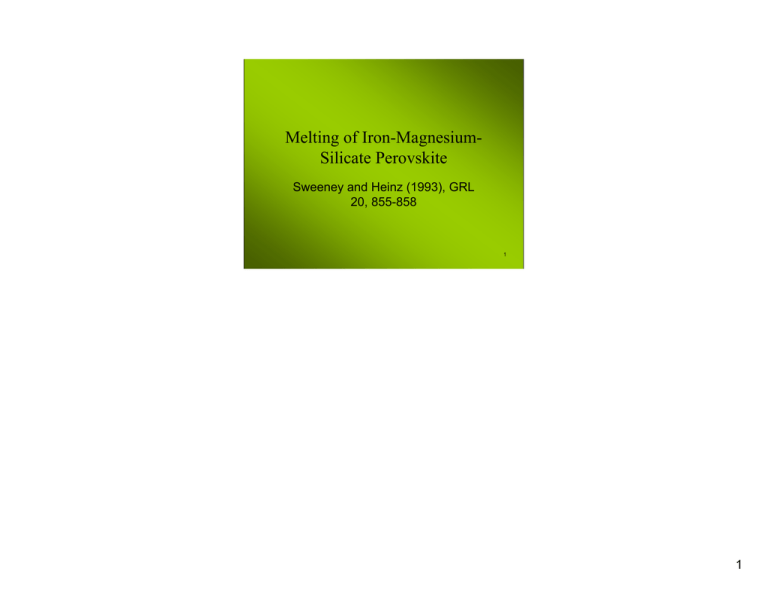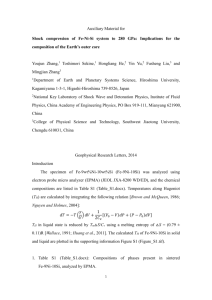Document 13567230
advertisement

Melting of Iron-MagnesiumSilicate Perovskite Sweeney and Heinz (1993), GRL 20, 855-858 1 1 Introduction 1. 2. 3. 4. Purpose of study Experimental method Results of the experiments Implications for the lower mantle and CMB 5. Conclusions 2 2 Why study the melting behavior of Fe-Mg-silicate perovskite? • Fe-Mg-silicate perovskite is believed to be the primary mineral phase in the lower mantle and the CMB. • The melting curve of this phase places an upper bound on the temperature of the lower mantle. • Previous studies identified lower and upper bounds of the melting curve; this study identified actual melting temperatures. 3 1. From 670 km down to CMB 2. Implications for style of solid-state convection in the lower mantle 3. Implications for chemical evolution of the mantle 3 Experiments Fe.14Mg.86SiO3 was melted in a laser-heated diamond anvil cell. 1. Enstatite + ruby (80% and 20%) loaded in 100µm sample chambers; without a pressure medium to prevent unwanted reactions. 2. After P calibration, the samples were converted to high P phases. 3. Heated to 1500 K by scanning with stabilized laser. 4. Linearly increase in temperature from 1500K, over four seconds. 5. Thermal analysis to determine the melting temperature. 6. P determined in center and at 3 µm from center to determine “P by measuring spring-length of the diamond anvil cell. 4 1. ­ 2. relaxation of samples and volume changes due to phase transitions decreased peak pressures by <10 percent. This decrease was compensated by thermal pressure at laser-heated spots. Results will show that the melting behavior is virtually independent of P 3. Up to 1500K to avoid Soret diffusion and melting. 4 High T signal Discontinuities in: • Thermal radiation • Temperature • Emissivity • Laser power Melting: • Sudden increase in brightness at center of heated spot. • Optically transparent (ppl) & isotropic (xpl) center of heated spot (≈5µm) after quenching and decompression (→ GLASS!). (uncorrected) Melting temperature = temperature immediately prior to the higher temperature signal. 5 5 Low T signal Discontinuities in time derivatives of: • Thermal radiation • Temperature • Emissivity I: Rapid diffusion of Fe (Soret diffusion): • Affecting the optical properties of the Fe-Mg-silicate perovskite. • Time intervals of < 1 (to 10s of) minute(s) near the melting temperature. Or II: Incongruent melting of Fe.14Mg.86SiO3: • “melting of a mineral with decomposition or reaction, such that it is replaced by a melt and a solid phase of different composition” Allaby and Allaby (1999). One would expect to find silica-enriched liquid + Fe-Mg-enriched solid. The complimentary solid phase has not been detected. 6 Soret diffusion: Heinz and Jeanloz (1987) found 10s of minutes, this study <1 min. Able to keep system at temp near melting for much longer time, without run-away occurring. Run-away = melt absorbs more laser power than the solid. Small heating spot -> large temperature gradients, rapid diffusion. Soret diffusion = thermal diffusion: lighter components migrate toward the hotter end. In order to establish an equal distribution of internal energy. Incongruent melting: volume of melt is small compared to volume probed by x-ray analysis, equally small volume of complementary phase could be missed among the strong and numerous diffractions of the perovskite phase! 6 Alternative interpretation for high T signal… Discontinuities in: • Thermal radiation • Temperature • Emissivity • Laser power I: Melting: • Sudden increase in brightness at center of heated spot • Optically transparent (ppl) & isotropic (xpl) center of heated spot (≈5µm) after quenching and decompression (→ GLASS!) Or II: Liquidus of Fe-Mg-silicate perovskite (uncorrected) Melting temperature = temperature immediately prior to the higher temperature signal. 7 7 Results Image removed due to copyright considerations. • Melting curve slope is slightly negative, but virtually P independent. • High T (±100K) and Low T (±85K) signals converge at higher pressures: ∆T=300K at 30 GPa and 140K at 94 GPa. • Scatter is possibly due to chemical heterogeneities. 8 8 Comparison with previous studies Image removed due to copyright considerations. • • • • • “Temperatures can be compared among experiments with different spot sizes if the radial temperature profiles have the same functional form”. Heinz and Jeanloz (1987) to 60 GPa Bassett et al. (1988) to 70 GPa Knittle and Jeanloz (1989) to 97 GPa This study: 30-94 GPa 9 Basset et al used different sample geometry and heating function. H+J (1987) same slope within error for melting curve, H+J may have overcorrected measured temperatures for temp fluctuations over time caused by laser-power fluctuations. K+J (1989) found significant pos slope for melting curve above 60 GPa. 900-1100 degrees lower at 95 GPa. 9 High P versus Low P experiments • Low P: integrated thermal radiation increased rapidly → destabilization of temperature control system. • High P: integrated thermal radiation shows a small but sharp decrease → temperature control system maintained stability Change in properties of either the melt or the solid near 60 GPa? Knittle and Jeanloz (1989): 0-25 GPa: liquid undergoes a continuous transition from 4- to 6-fold coordination of Si, but Si is still predominantly octahedrally coordinated. >60 GPa: Si coordination has uniformly approached 6, the melt becomes less compressible: structural changes no longer contribute to compression → ∆V >0. “The melting curve of (Mg,Fe)SiO3 perovskite is close to that of Fe.” 10 High P experiments up to 900-1100 K higher temperatures than this study 10 Implications for the mantle and the CMB Alternative viscosity structures for the lower mantle: • HT-IntP: viscosity controlled by diffusional processes: diffusional rates scale with Tmelt. • Viscosity increase in the lower mantle is implied from high P behavior of Knittle and Jeanloz (1989) • From this study: no viscosity increase is needed. • Slope in T-P projection of a univariant reaction is given by the Clapeyron equation. Melting of Mg enriched Fe-Mg-silicate perovskite has a ∆S>0, therefore ∆V<0. ∆Vr ⎛ ∂T ⎞ <0 ⎟ = ⎜ P ∂ ⎠ ∆G ∆S r ⎝ • Crystalline phase is slightly buoyant. This could have implications for the chemical evolution of the mantle. 11 Diffusional process controlled viscosity: weertman creep?? e.g. Neutrally buoyant perovskite in a chondritic melt, then chemical differentiation of the mantle could not be explained by perovskite crystal fractionation. And melting of mantle would not be precluded by minor element partitioning between the liquid and perovskite since the nearly equal densities would lead to homogeneous mixing by vigorous convection. 11 Conclusions • The low temperature signal has been interpreted as rapid diffusion of Fe. • The high temperature signal has been interpreted as melting of the Fe-Mg-silicate perovskite • The melting curve appears to be virtually independent of P. • The new melting curve is several hundred degrees below previous estimates. • New upper bound for temperature of lower mantle. • No viscosity increase in the lower mantle is implied from this study. 12 12





